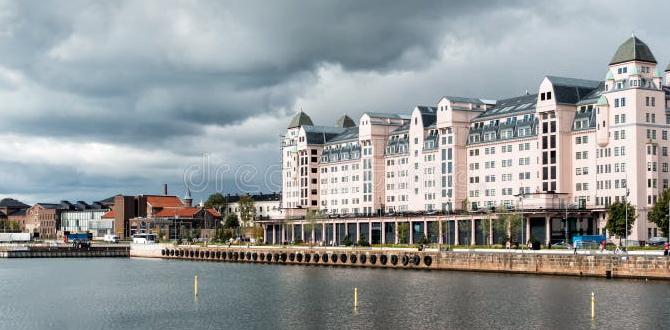Australia’s food neighborhoods are diverse areas celebrated for their unique culinary offerings, from bustling city markets to quiet suburban gems. Understanding these foodie hotspots makes exploring Australian cuisine exciting and delicious, turning every meal into an adventure.
Planning a trip to Australia, or perhaps you’re a local looking to explore your own backyard better? Deciding where to eat can feel overwhelming with so many fantastic options. What if there was a way to pinpoint exactly where to find the best dishes, from authentic street food to gourmet delights, without the guesswork? This guide is here to help you navigate Australia’s vibrant food scene, transforming any dining decision into a confident and mouthwatering experience. We’ll break down what makes certain neighborhoods culinary destinations and how you can discover them. Get ready to eat your way across Australia!
What are Australia Food Neighborhoods?
Australia food neighborhoods, often referred to as ‘foodie precincts’ or ‘culinary hotspots,’ are specific urban or suburban areas renowned for their concentration of diverse and high-quality food establishments. These neighborhoods aren’t just places with restaurants; they are districts where food culture thrives. They are characterized by a unique blend of eateries, from bustling farmers’ markets and artisanal bakeries to world-class restaurants, trendy cafes, and hidden ethnic eateries. These areas often develop organically, driven by local communities, chefs, and entrepreneurs who create a dynamic culinary landscape.
The appeal of these food neighborhoods lies in their walkability and the sheer variety they offer. You can often spend a day (or more!) exploring, sampling different cuisines and experiences without traveling far. Think of Melbourne’s laneway cafes, Sydney’s vibrant Asian dining scenes, or Adelaide’s focus on fresh, local produce. These areas become destinations in themselves, attracting locals and tourists alike who are eager to explore the gastronomic heart of a city.
Factors That Define a Food Neighborhood:
- Concentration of Eateries: A high density of restaurants, cafes, bars, and food shops.
- Diversity of Cuisine: A wide range of culinary styles, from traditional Australian to international flavors.
- Quality and Innovation: A reputation for excellent food, fresh ingredients, and creative culinary approaches.
- Atmosphere and Vibe: A unique ambiance that encourages dining, socialising, and exploration.
- Supporting Businesses: Proximity to markets, delis, bakeries, and specialty food stores that complement the dining scene.
- Cultural Influence: Often, a neighborhood’s history or dominant cultural group influences its food offerings.
Why Understanding Food Neighborhoods Matters for Travelers (& Locals!)
For travelers, identifying these food neighborhoods is a game-changer. Instead of relying on generic recommendations or disappointing tourist traps, you can strategically plan your culinary adventures. This means more authentic experiences, better value for money, and a deeper connection to the local culture. Imagine knowing exactly where to go for the best sourdough in Perth or the freshest seafood in Brisbane without spending hours searching.
It’s also incredibly beneficial for locals. We often get stuck in our usual routines, visiting the same few restaurants. Understanding the food neighborhoods in your own city or a neighboring one can introduce you to new flavors, support small businesses, and inject some excitement back into your dining life. It opens up a world of culinary discovery right on your doorstep!
Benefits of Knowing Food Neighborhoods:
- Smarter Dining Choices: Avoid tourist traps and find genuinely good food.
- Cultural Immersion: Experience the local way of eating and life.
- Discover Hidden Gems: Uncover authentic, often family-run, establishments.
- Efficient Exploration: Maximize your time by knowing where to focus your appetite.
- Support Local Economy: Direct your spending towards businesses that define the area.
- Budget-Friendly Options: Many food neighborhoods offer a range of price points, from cheap eats to fine dining.
How to Discover Australia’s Top Food Neighborhoods
Finding these culinary havens is easier than you might think. A little research and a willingness to explore will lead you to some of Australia’s most delicious spots. Here’s how you can start your foodie exploration:
1. Leverage Online Resources
The internet is your best friend when it comes to discovering food neighborhoods. Look for reputable food blogs, travel websites, and city guides. Websites like Taste.com.au or broader travel platforms often feature articles dedicated to “best food streets” or “culinary destinations” in major Australian cities.
2. Follow Local Food Influencers
Many cities have local food bloggers, Instagrammers, or journalists who are passionate about their city’s food scene. Following them can give you real-time insights into new openings, popular spots, and emerging food neighborhoods.
3. Consult Tourist Information Centers
Don’t underestimate official channels! Local tourist information centers often have excellent resources, maps, and staff recommendations specifically highlighting areas known for their food and drink. These are usually geared towards providing practical, reliable advice.
4. Ask Locals (The Right Ones!)
If you’re in Australia, engage with locals who are passionate about food. This might be your hotel concierge, a shop owner in a market, or even a friendly barista. Ask them for their favorite spots or “what’s the best area for ____ cuisine?”
5. Explore with an Open Mind
Sometimes, the best discoveries happen by accident. Dedicate some time to simply wander through different neighborhoods. Look for streets with a high density of interesting-looking cafes, restaurants, and food shops. Observe where locals are gathering.
Key Food Neighborhoods Across Australia: A City-by-City Guide
Australia is a vast continent, and its culinary landscape is as diverse as its geography. Each major city boasts its own unique food precincts, shaped by history, culture, immigration, and innovation. Let’s dive into some of the most celebrated food neighborhoods in Australia’s capital cities.
Sydney, New South Wales
Sydney is a melting pot of cultures, and its food scene reflects this brilliantly. From bustling Chinatown to sophisticated harborside dining, there’s something for every palate.
Chinatown (Dixon Street & Surrounds)
This is Sydney’s vibrant epicentre for authentic Chinese and other East Asian cuisines. Dixon Street itself is a spectacle, but the surrounding laneways and streets offer an even richer tapestry of Cantonese, Sichuan, Vietnamese, Korean, and Japanese eateries. You’ll find everything from bustling yum cha restaurants and steaming noodle bars to dessert shops and specialty Asian grocers.
- Must-Try: Dumplings, Peking Duck, Pho, Bubble Tea.
- Vibe: Lively, bustling, authentic, sensory.
Surry Hills
Known for its bohemian charm and trendy eateries, Surry Hills is a go-to for innovative Australian cuisine, excellent coffee, and a sophisticated dining experience. Crown Street and its side streets are lined with stylish restaurants, bars, and cafes catering to diverse tastes, including Middle Eastern, Italian, and modern Australian.
- Must-Try: Modern Australian brunch, artisanal coffee, contemporary global cuisine.
- Vibe: Trendy, chic, relaxed yet sophisticated.
Newtown & Enmore
These neighboring suburbs are famed for their eclectic and affordable food scene. Newtown, in particular, offers a vibrant mix of Thai, Vietnamese, Indian, and vegetarian/vegan options. Enmore Road boasts a similar unpretentious charm with plenty of restaurants and pubs serving up hearty meals.
- Must-Try: Pad Thai, Banh Mi, vegetarian burgers, cheap eats from around the globe.
- Vibe: Bohemian, alternative, vibrant, unpretentious.
Melbourne, Victoria
Melbourne proudly wears its crown as Australia’s culinary capital, famous for its laneway culture, coffee obsession, and diverse international flavors.
Melbourne CBD Laneways (Degraves Street, Centre Place, Flinders Lane)
The heart of Melbourne’s food scene lies hidden in its labyrinthine laneways. Degraves Street and Centre Place offer a sensory overload of cafes serving incredible coffee and hearty brunches, small eateries with diverse menus, and bakeries. Flinders Lane is known for its more upscale restaurants and testing kitchens.
- Must-Try: Specialty coffee, smashed avocado, gourmet sandwiches, fine dining.
- Vibe: Energetic, artsy, cozy, urban.
Brunswick Street, Fitzroy
Fitzroy’s Brunswick Street is a hub for alternative culture and a thriving food and drink scene. You’ll find a mix of trendy cafes, pubs with character, excellent vegetarian and vegan restaurants, and international flavors ranging from Italian to Middle Eastern. It’s a great place to wander and stumble upon delicious finds.
- Must-Try: Craft beer, plant-based dishes, global street food, bohemian cafes.
- Vibe: Hip, alternative, lively, artistic.
Victoria Market Area (Queen Victoria Market)
While the market itself is a destination for fresh produce, gourmet goods, and delicious street food, the surrounding streets are also dotted with cafes and restaurants that take advantage of the fresh ingredients. It’s the perfect place to sample local produce and artisanal products.
- Must-Try: Fresh produce, cheese, cured meats, borek, dim sum, coffee.
- Vibe: Bustling, traditional, vibrant, sensory.
Brisbane, Queensland
Brisbane offers a relaxed dining scene with a focus on fresh, local produce, especially seafood, and a growing number of international culinary influences.
James Street, Fortitude Valley
This stylish precinct is home to some of Brisbane’s most acclaimed restaurants, chic cafes, and boutique bars. Known for its high-end dining, innovative concepts, and focus on local ingredients, James Street offers a sophisticated culinary experience.
- Must-Try: Modern Australian, seafood, fusion cuisine, artisanal cocktails.
- Vibe: Chic, sophisticated, trendy, vibrant.
Howard Smith Wharves
Nestled under the iconic Story Bridge, this riverside destination offers a stunning backdrop for dining and drinks. It features a variety of restaurants and bars, focusing on relaxed, riverside dining with excellent views and a great atmosphere, especially in the evenings.
- Must-Try: Seafood platters, casual pub fare, craft beers, waterfront dining.
- Vibe: Lively, scenic, relaxed, urban.
West End
Brisbane’s West End is a multicultural hub with a vibrant, bohemian feel. It’s renowned for its diverse range of affordable eateries, particularly authentic Greek, Vietnamese, and Middle Eastern cuisines. You’ll also find lively cafes and small bars.
- Must-Try: Greek souvlaki, Vietnamese pho, Middle Eastern mezze, independent cafes.
- Vibe: Multicultural, bohemian, relaxed, community-focused.
Adelaide, South Australia
Adelaide is often lauded for its ’20-minute city’ convenience and its exceptional food scene, which heavily emphasizes fresh, regional produce and a burgeoning small bar culture.
East End (Rundle Street, Ebenezer Place)
Adelaide’s East End is a vibrant pocket brimming with cafes, restaurants, and bars. Rundle Street and the charming, cobblestoned Ebenezer Place offer a fantastic mix of trendy eateries, pubs, and places to enjoy a coffee or a cocktail, often with live music.
- Must-Try: Modern Australian, small bar tapas, international flavors, artisanal coffee.
- Vibe: Trendy, relaxed, artistic, bustling.
Central Market Area (Gouger Street)
Alongside the iconic Adelaide Central Market (a must-visit for fresh produce and gourmet delights), Gouger Street is historically Adelaide’s Chinatown and remains a prime destination for authentic Asian cuisine. You’ll find excellent Chinese, Korean, Vietnamese, and Malaysian restaurants here.
- Must-Try: Chinese banquets, Korean BBQ, Vietnamese pho, fresh market produce.
- Vibe: Bustling, authentic, diverse, vibrant.
Wines & Culinary Trail Regions (Barossa Valley, McLaren Vale, Adelaide Hills)
While not strictly urban neighborhoods, South Australia is world-renowned for its wine regions, which are also culinary destinations. These regions are home to incredible wineries with exceptional restaurants, farm-to-table experiences, and artisanal food producers. Wine Australia provides extensive information on these areas.
- Must-Try: Regional wines, premium produce, winery luncheons, artisanal cheeses and chocolates.
- Vibe: Scenic, relaxed, gourmet, rustic.
Perth, Western Australia
Perth’s food scene is growing rapidly, with a focus on fresh, local ingredients, seafood, and a vibrant small bar culture, particularly in the city center and its surrounding coastal suburbs.
Leederville & Mount Hawthorn
These trendy inner-city suburbs have transformed into foodie hotspots. Leederville, in particular, along Oxford Street, is packed with buzzing cafes, innovative restaurants, and craft beer pubs. Mount Hawthorn offers a similar, slightly more relaxed vibe with excellent eateries.
- Must-Try: Fusion cuisine, creative brunches, artisanal coffee, craft beer.
- Vibe: Trendy, chic, relaxed, lively.
Northbridge
Perth’s cultural heart, Northbridge, is home to a diverse array of restaurants, bars, and cafes. It offers a strong representation of Asian cuisines (Chinese, Thai, Japanese), along with modern Australian and Italian eateries. It’s also the nightlife hub, so dining here often blends with evening entertainment.
- Must-Try: Authentic Asian dishes, casual dining, diverse international options.
- Vibe: Eclectic, vibrant, multicultural, energetic.
Elizabeth Quay & South Perth
These newer waterfront developments offer stunning views and a selection of modern restaurants and bars. Elizabeth Quay in the CBD provides easy access to a range of casual and upscale dining, while South Perth offers riverside restaurants with views back towards the city skyline.
- Must-Try: Seafood, modern dining with views, casual waterfront meals.
- Vibe: Modern, scenic, relaxed, family-friendly.
Hobart, Tasmania
Hobart punches well above its weight with a food scene heavily influenced by Tasmania’s incredible produce, pristine environment, and a strong farm-to-table ethos.
Salamanca Place & Battery Point
Salamanca Market on Saturdays is iconic, but the surrounding Salamanca Place and the charming, historic streets of Battery Point are year-round food destinations. You’ll find excellent pubs, cafes, and restaurants serving modern Australian cuisine that highlights local Tassie produce, especially seafood and beef.
- Must-Try: Oysters, scallops, Tasmanian salmon, local craft beer and wine, pub fare.
- Vibe: Historic, charming, relaxed, bustling (especially market day).
North Hobart (Elizabeth Street)
This vibrant strip is Hobart’s foodie hub, boasting a fantastic concentration of restaurants with cuisines from all over the world. It’s famous for its diverse range of Italian, Indian, Mexican, and Vietnamese options, alongside innovative modern Australian eateries. It’s a great place for a progressive dinner!
- Must-Try: Authentic European, Asian, and Mexican cuisines, trendy cafes.
- Vibe: Lively, eclectic, diverse, friendly.
Tips for Maximizing Your Food Neighborhood Experience
Exploring Australia’s food neighborhoods is an adventure, and like any good adventure, a little preparation can go a long way. Here are some tips to ensure you get the most out of your culinary explorations:
1. Plan, But Be Flexible
Have a list of neighborhoods or specific restaurants you’re keen to try, but be open to spontaneous discoveries. Sometimes the best meals are found unexpectedly!
2. Go Local for the Best Coffee
Australia takes its coffee very seriously. Look beyond the chain names and seek out the independent cafes in these foodie precincts. Ask for a flat white or a long black – Australian coffee staples.
3. Embrace the Farmers’ Markets
Many food neighborhoods are anchored by or have strong links to local farmers’ markets. These are goldmines for tasting local produce, artisanal goods, and often finding delicious ready-to-eat snacks. Check local listings for market days and times.
4. Consider a Progressive Meal
In areas with a high density of eateries, why not have your entree at one place, your main at another, and dessert somewhere else? It’s a fun way to sample more flavors.
5. Don’t Shy Away from Ethnic Enclaves
Australia is a multicultural nation. Exploring neighborhoods known for specific ethnic cuisines (like Sydney’s Chinatown or






